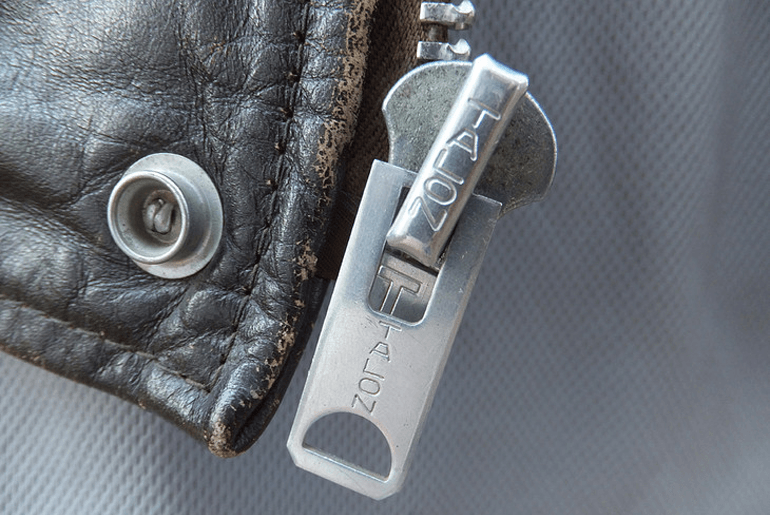- Heddels
- Posts
- June 18 - The History of Seersucker: A Wrinkle in Summer Fabrics
June 18 - The History of Seersucker: A Wrinkle in Summer Fabrics
Together With
The History of Seersucker: A Wrinkle in Summer Fabrics
The bumpy and often 'candy striped' fabric we call seersucker is a warm weather staple synonymous with the American south.
Will Varnam

Not every day is raw denim day. Unless you’re a masochist, you’re rocking lightweight fabrics in the summer to help keep you cool in the warmer months and leaving jeans, boots, and jackets in the wardrobe. We’ve covered the most popular warm-weather fabrics in our article Keeping Cool: A Guide to Summer Fabrics, but today we’re going to delve deeper into one of them: seersucker.
A long-standing summer staple, we’re going to look into the origins of seersucker, how it’s defined, its cultural significance, and the most common ways it’s worn. There’s more to this humble and understated fabric than the Kentucky Derby, so sit back in your easy chair, let the breeze flow, and pour yourself a Negroni.
What is Seersucker?
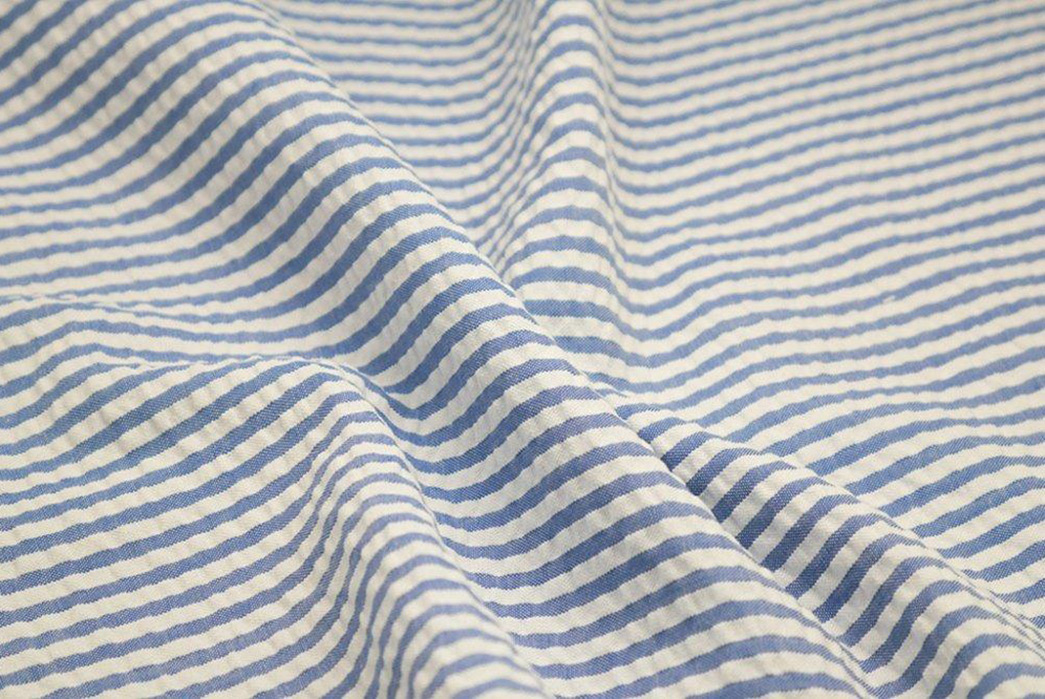
A close-up of a traditional blue and white striped seersucker fabric, showing the texture created by the weaving method. Image via Barrington Fabrics.
At its most basic level, seersucker is a thin, puckered, all-cotton fabric. It is commonly striped or checkered, most associated with summer wear and garments worn in warmer climates. Typically seen in white and blue stripes, it can be found in other colors like yellow, pink, or green, also alternating with white stripes, or be plain colored.
Seersucker is often used for suits, shirts, shorts, dresses, and robes, with its key benefit being its lightweight nature and breathability.
If you have ever been up close and personal with seersucker, you’ll notice that it is woven in such a way that some of the threads bunch together to give the fabric a wrinkled appearance and texture. While wearing a wrinkled suit may not sound like the most suitable formal wear, it allows the fabric to be held mostly away from the skin when worn, allowing air to circulate. As an added benefit for many of us, it doesn’t require pressing or ironing.
The name seersucker is said to originate from the Persian words shîr and shakar, which translate to “milk and sugar”. This more than likely references the smooth and bumpy texture of the fabric, as well as evidencing the origin and popularity of the fabric in the Middle East. During the British Colonial era, seersucker was a popular choice of fabric in countries like India, whose climate was warm and muggy. However, it is also evidenced that seersucker was used as early as the US Civil War, to make haversacks and famously the baggy pants of the Confederate Zouaves like the Louisiana Tigers.
In addition to clothing, seersucker was also used during the Victorian era for mattresses and pillowcases, becoming known as bed ticking. Again, seersucker proved to be a more breathable and aerated fabric in the hot summers of British colonies and the southern states of the US.
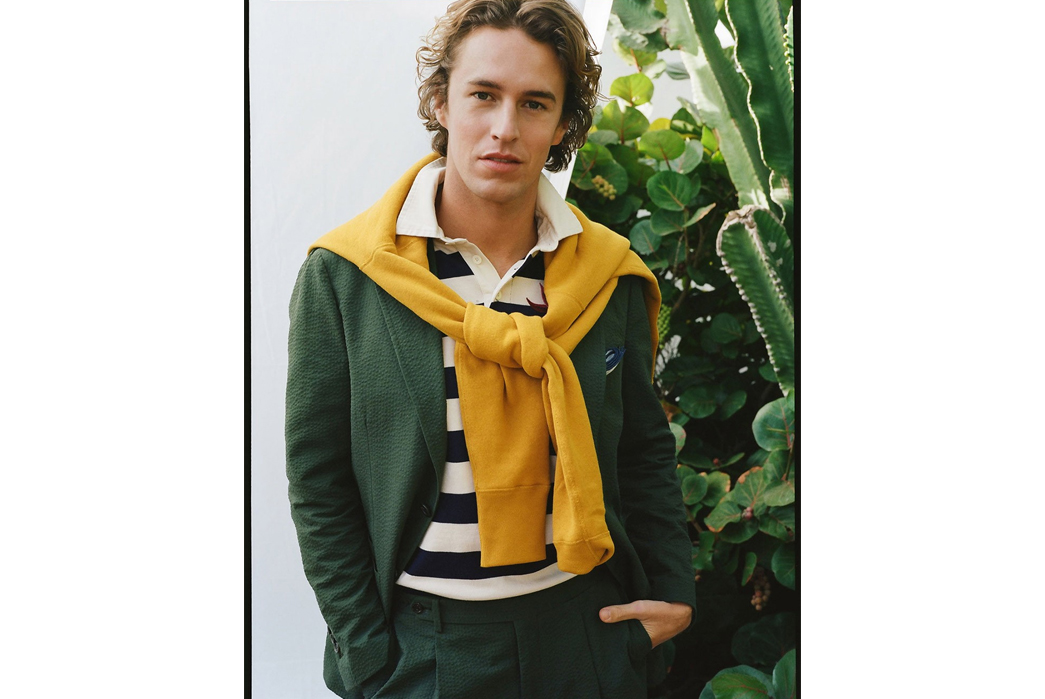
A more unconventional seersucker suit in olive (image via Drakes)
Construction
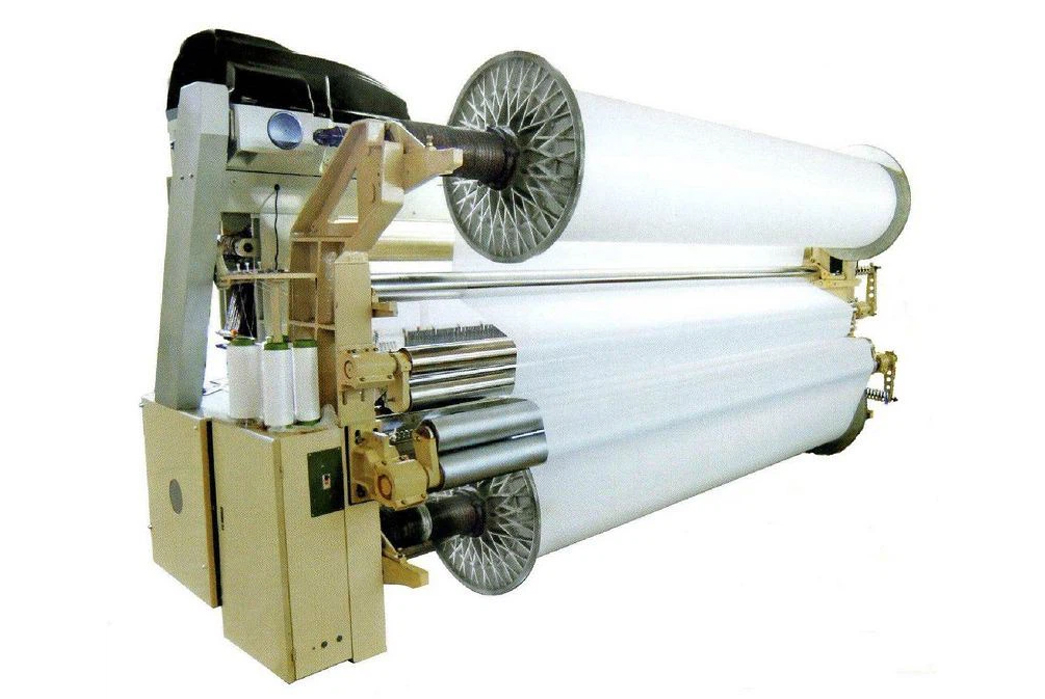
A modern twin-beam loom that would be able to weave seersucker in the process described below. Image via Air Jet Looms.
Traditionally made from cotton, linen, or synthetic fibers, seersucker is woven on twin-beam looms that weave at different speeds, which gives the fabric its trademark appearance and texture. Many fabrics are woven with the warp yarn held in uniform tension, but what distinguishes seersucker is the slack-tension weaving process, which means two warps must be used. One is held at a regular tension, the other is held at a different (most likely higher) tension, which produces the fabric’s distinct crinkled appearance. Research has been conducted to weave seersucker on traditional single-beam looms, however, traditional seersucker is woven on a twin-beam loom.
/In Partnership with Devium USA/
We’ve been waxing lyrical about waxed canvas for years, and we ain’t stopping today. Devium has dropped its Overdrive Waxed Canvas Jacket, providing us with yet another waxy, workwear-inspired piece to bring to your attention.
A true 4-season piece, the Overdrive is made from waxed canvas and lined with comfy cotton plaid. Just like every Devium garment, every fiber of this jacket is made in the USA, from the waxed canvas all the way down to the hardware and labels.

Available in 3 colorways, each variant has one thing in spades – texture. The waxed canvas has that crinkly look that we know and love, the cotton flannel has a slightly uneven weave and whimsical shadow plaid, and the heavy-duty zippers are made of antique brass that has a mottled appearance from the jump.
Get yours from Devium for $358

Seersucker via J. Press.
Rise to Fame
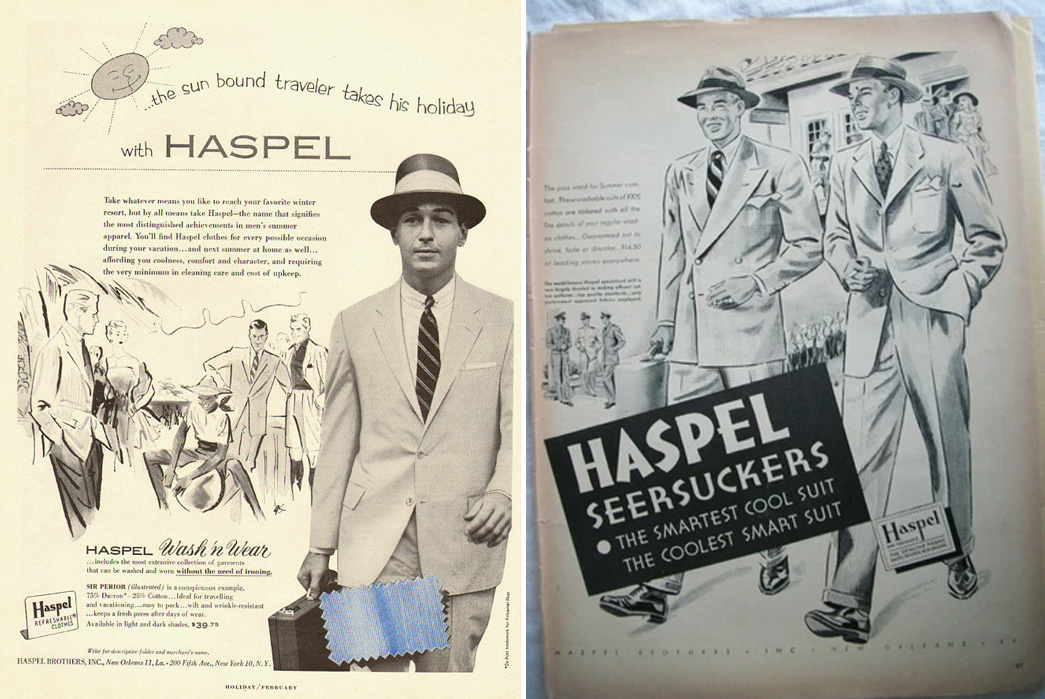
Vintage Haspel seersucker ads via A Continous Lean & Angela’s Vintage Ads.
While seersucker had been popular during the nineteenth century, it gained its iconic status for its role in menswear during the twentieth century. Around 1909, New Orleans clothier Joseph Haspel Sr. began to make suits from seersucker, which gained regional popularity due to their comfort and suitability for warmer weather. It is said that Haspel had been manufacturing workwear clothing for factory workers and felt that businessmen shouldn’t have to suffer in hot offices, so he started a production run of seersucker suits at his New Orleans factory.

Haspel and his ocean antics, via Haspel.
Legend has it that while promoting his suits at a convention in Boca Raton, Florida, Haspel walked into the ocean up to his neck in his seersucker suit. He came out, hung the suit to dry that afternoon, and then proceeded to wear it to the convention dinner that evening, looking sharp and smart.

1970 Brooks Brothers catalog featuring seerecuker, via The Cary Collection
However, it is also said that Brooks Brothers introduced the fabric around the turn of the century, leading to a hotly contested debate as to who can lay claim to the seersucker revolution. Whatever the case, we know that the fabric’s rise occurred around this period and then in the 1920s when it was used by preppy undergraduate college students and professors alike. Seersucker became a staple on college campuses across the US, particularly at Ivy League schools, where students often wore one seersucker garment (often, a blazer) whereas academic staff were known to wear full suits with a red bow tie. By the 1950s, many well-known brands, including Sears and Macy’s, had joined the ranks of Brooks Brothers and Haspel in manufacturing formal wear out of seersucker, cementing its place in the male wardrobe.
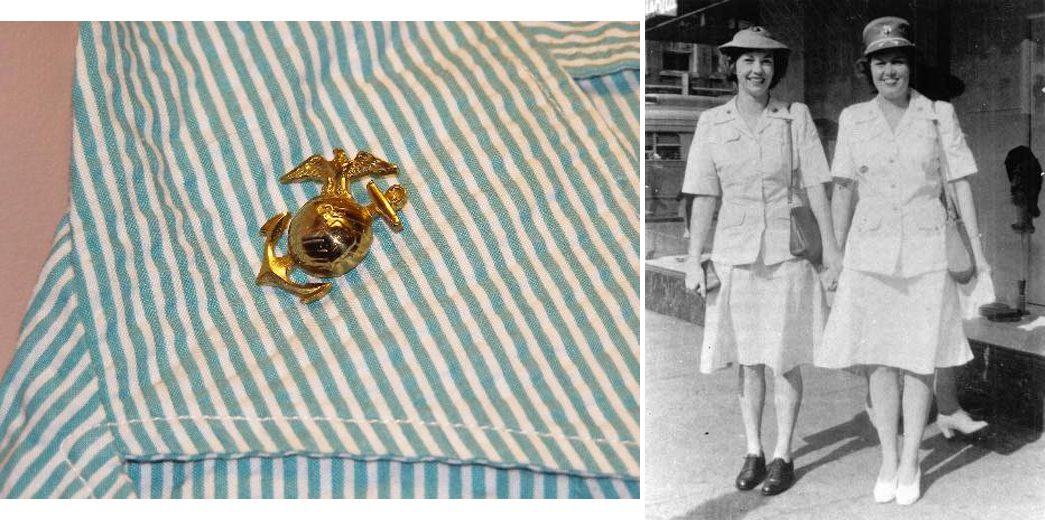
Close up of a USMCWR green and white striped seersucker uniform from WWII (left, via Quest Masters), A period image of two USMCWRs wearing the seersucker summer uniform (right, via National Parks Service)
But it wasn’t just men who were attracted to the qualities and aesthetics of seersucker. During the Second World War, Capt. Anne A. Lentz was one of the first female officers to run the US Marine Corps Women’s Reserve, and seersucker was chosen as the summer uniform of this newly created branch of service. Nurses and hospital volunteers during the 1940s also famously wore a blue and white seersucker fabric, which came to be known as ‘candy stripe’ and would leave a lasting impression on injured servicemen in many a military hospital.
It’s important to know that seersucker was not always worn by the leisure class. Its early use as a military fabric in the U.S. Civil War saw seersucker drip into workwear in the hot south, which led to it being adopted by the proletariat. Perhaps this would explain why it took an eccentric salesman like Haspel to sell a fabric associated with the poor to well-to-do business and academia types.
Seersucker Thursday
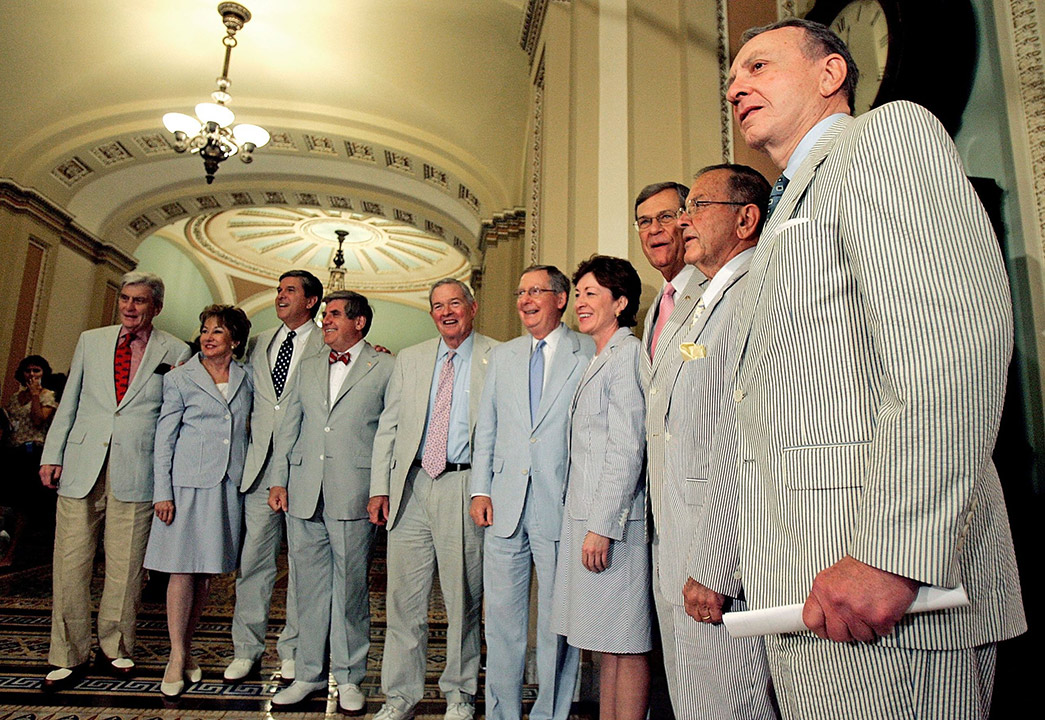
Seersucker Thursday in Washington (Image via Getty)
In 1996, the US Senate held ‘Seersucker Thursday’ in June, which encouraged participants to dress in traditionally southern clothing. Former Senate Majority Leader Trent Loft declared the day and stated that “the Senate isn’t just a bunch of dour folks wearing dark suits”. National Seersucker Day stood until 2012 when the tradition was discontinued, although only a couple of years later it went through a revival, with mixed success. The Washington Post reported that Senate cloakroom staff told members of the House that some senators thought “it would be politically unwise to be seen doing something frivolous when there’s so much conflict over major issues”.
Although National Seersucker Day was a fairly recent invention, it’s said by some that seersucker suits originally became popular in government during the early part of the twentieth century, with their lightweight and breathable properties becoming a quick hit in the former swamp that is DC. However, as air conditioning came to be installed, its popularity dropped. While some continue to wear seersucker, it remains a controversial issue within the government, which sees as many for as against.
Return to Mainstream Popularity
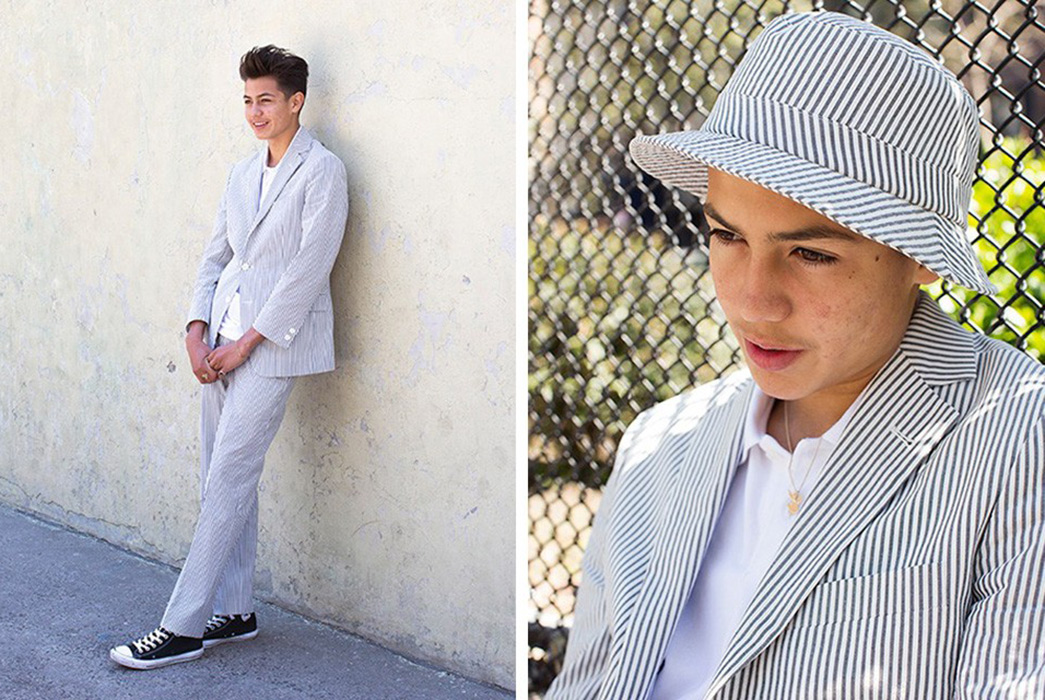
Brooks Brothers x Supreme collaboration
In the early 2010s, menswear saw a return to favor for seersucker, as a result of the increased interest and popularity of preppy and Ivy style. Coinciding with #menswear and a thirst for ‘Made in the USA’, the fabric was injected with a variety of colors, and fits were updated for the contemporary man. Films like The Great Gatsby (2013) even encouraged ‘Seersucker Social’ events to take place across the US, where participants dressed in period vintage clothing and emulated the styles of the 20s and 30s. Its popularity wasn’t restricted to the US either, with the 2016 Australian Olympic team being outfitted in green and white seersucker blazers for the Brazil games.
Modern Seersucker Products
J. Press
J. Press Seersucker Sport Coat & Trousers, available from J. Press for $698 & $228 respectively (Made in Canada)
J. Press Blackwatch Tartan Seersucker Shirt, available for $128 from J. Press
J. Press Seersucker Shirt, available for $128 from J. Press.
Allevol
Allevol Brunel Trouser, available for $355 from Clutch Cafe.
Sun Surf
Sun Surf Cotton Seersucker Open Shirt – Trip to Hawaii – available for $190 from HINOYA.
Like this? Read these:
What did you think of today's newsletter? |








